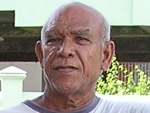|
|
|
The Story of Hosay: Dancing the Moon |
Michael Goring Speaks on Hosay
Pages: 01 | 02 | 03 | 04 | 05 | 06 | 07 | 08
Staff Article
Interview Recorded: May 25, 2005
Posted: June 27, 2005
In commemoration of Hussain

Michael Goring
|
Long ago you had the older folks doing Gatcar, which is the stick fight, but we do not have that anymore. We also had Fire Pass. That is when you dance with a stick of fire. We do not have those things anymore. We have lost all the things that used to make Hosay what it was. On the night of the big procession you would have older women who would sing songs and throw rice and money. They would sing 'Messiah'. It is like when you have a wake and you are lamenting.
There are problems that we are having presently as I had mentioned earlier this week to you. For example, the lead Hosay is the Panchaite Hosay, and Panchaite means it is built for you, by you. But now the government has intervened, and everybody is a Panchaite. We were taught that whatever we do comes from inside. The elders couldn't afford to do certain things by themselves, so you had people who would give a bag of flour, one will give some coffee, and another one will give something else. That is how the Panchaite came about. When it became popular, the families realized that they had problems, so they wanted to build something. They kept doing it for the love of it. You, the outsider, cannot work with them, but you can go to the Panchaite. You can make an offering to the Panchaite. You can also go and touch it and nobody would say anything. So in truth and in fact, that is yours because it was built for you, by you. You did not do the actual building, but you were supportive.
We are losing all of those things now. The Moon at the end of the procession of the final day has to go back to Goolam Hussain's yard where they bury their stuff. It is also one of the places where they do the preparation (the Carbala). They go to Q.R.C. to pray, and that prayer is like the rest point where Hussein and his band of people pray before going into battle. The Goolam Hussain's yard is the Carbala. When he went into battle, he battled at the Carbala. I do not know how much attention you have paid to the Moon, but if you have noticed, on one side is very pretty, and on the other side there is a string with a bag, which they call the Muckna. Whatever secrets they have, they will put them in that bag. At the end of the procession, it has to come off and be buried. Also, the position of the hands on the Moon is supposed to be facing forward, not backward.
On one Moon there is a sword, and on the blue Moon there is an arrow. You do not see the whole arrow; you see the end of the arrow. People do not pay attention to it because they think it is a knife. The blue Moon is the bigger of the Two Brothers, which is Hassan. He died by poison twelve years and forty days before Hussain. Hussain died by sword. When the procession is finished, the Hosay stays in the yard for one day, and on the following day they keep a prayer and you have Tejah. That is when they call all the people. They feed the people who were involved with the Hosay, and also the neighbours. They then take the Hosay and they throw it away. They have to cut up the Hosay before they throw it away.
We have problems with the young people because they do not understand so many things. If and when they learn that we can take pieces of wood, cardboard, pretty paper and a lot of time and talent, and build something in commemoration of Hussain, and that people will come to admire it, then they must be strong enough to take it out and send it away. A lot of people do not understand the 'Beating of the Drum' or the 'Turning of the Moon'. We who are in it have noticed that the young people, unfortunately, were never taught by the older ones. You do not start Dancing the Moon and not Salami, which means touch it. You touch the Hosay. You are not supposed to walk from one Hosay to the other Hosay without Dancing the Moon.
Continue...
Pages: 01 | 02 | 03 | 04 | 05 | 06 | 07 | 08
|

|

